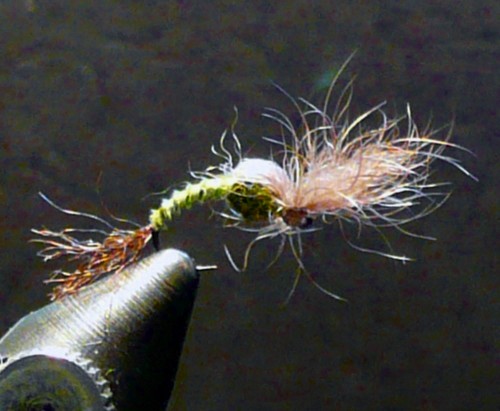
On The Fly
January 2012
"Fly tying is a school from which we never graduate"
TYING NEWS
The Southern Oregon Fly Tyers invite you to attend their meetings the second Tuesday of
each month. The next meeting is January 10, 2012. The meetings start at 6:00 PM, at the Madrone Hill
Mobile Home Park community building near Gold Hill. Bring a friend, come early so you don't miss
anything, and stay late. Tyers need not be experienced, and those with all levels of skill are
welcome. Each meeting a member is encouraged to demonstrate a new or different skill, from simple
to difficult. For more information, call Dan Kellogg at 773-4724.
DIRECTIONS: Take Gold Hill Exit #40, off of I-5 and go west, toward Jacksonville, 1.3 miles, until you
reach the brick entrance way to the Madrone Hill Mobile Home Park on the right. You’ll pass a golf course
parking lot on your left shortly after leaving the freeway. After you turn right into the
mobile home park, proceed to the community building which is located about 100 yards ahead on the left. The
address is 8401 Old Stage Rd. Please park your vehicle on the bare dirt in the parking lot to avoid the
wooden septic covers in the grass
 PATTERN OF THE MONTH -BWO SnoShu Pull-Over
PATTERN OF THE MONTH -BWO SnoShu Pull-Over
Hook: Daiichi 1130, Curved, down eye, 16-20.
Thread: 8-0 olive.
Tail/Shuck: Brown marabou.
Abdomen: Olive goose or turkey biot.
Thorax: Olive fine & dry dubbing.
Wing: Dun Snow Shoe Hare, pulled over thorax.
Tying Instructions:
Step 1 Mash the barb and mount the hook in the vise.
Step 2: Start the thread one eye width behind the eye and lay down an even thread base to a position just
past the sharp bend of the hook.
Step 3: Select a small bunch of marabou fibers, measure 3/4 the body length, and tie in on top of hook at
the rear of the thread base. Secure butts with spiral thread wraps on top of the shank the length of the
body and trim excess.
Step 4: Select a biot from a goose or turkey primary flight feather. Tie it in by the tip and wind it
forward in overlapping turns to the 2/3 point on the shank. Tie off and trim excess.
Step 5: Select a small bunch of long fur from the bottom of a Snow Shoe Hares foot, clean out the under-fur,
measure 1 1/2 body length, and tie on top of the shank with the tips pointing rearward at the 2/3 point.
Bind the hair down with several tight thread wraps taking care to keep all the fur on top of the shank.
Trim the excess at a taper towards the eye of the hook.
Step 6: Spin a small amount of dubbing thinly onto the tying thread and take 3 turns forward forming a
thorax. Tie off and trim excess.
Step 7: Now pull the Snow Shoe fur forward over the thorax and bind down at the front of the dubbed thorax.
The fur fibers should now be pointing forward over the hook eye.
Step 8: Lift the fur slightly upward away from the eye and take some thread wraps in front of the wing and
still behind the eye, cocking the wing up, forming a neat head. Whip finish and cement.
The BWO SnoShu Pull-Over is a recent pattern but its ancestors go back to the 40's & 50's
and a young tier named Fran Betters. He hailed from Wilmington in upstate New York. Fran is well known for
the development of the Ausable Wulff, Haystack, and the Usual patterns. The flies that he invented back
then are very impressionistic, rough-looking imitations designed to handle the rigors of the fast moving
Ausable River. The Haystacks were designed while Fran was still in High School and were a refined version
of a pattern tied by trapper Eddie Lawrence. The Usual is an outgrowth of the Haystack series using snowshoe
rabbits foot hair instead of deer hair. Today’s Pull-Over takes the wing over the thorax, along with a
heavier hook, a non-floating body, and a lively tail, to form an emerger.
This remarkable hair is translucent and very waterproof, making the wing buoyant in the
surface film. This kink resistant, non absorbent hair floats just as well as CDC and deer hair without some
of the disadvantages with durability. The dense curly under fur hold a lot of air bubbles and is easily
compressed, so it is tied in without too much bulk.
Tying tips:
The Snowshoe hair can be used as a substitute for many wing and tail materials. How about
a Snowshoe Caddis instead of the elk hair, or a Snowshoe Sparkle Dun, you get the idea. They all are quick
ties and very effective patterns. Of course their size and color can be easily adapted to local
circumstances.
So tie some up, give them a test flight, and let me know how you do.
Tie One On,
Dan Kellogg
(you can contact me at FLYGUY@EZNORTHWEST.COM)
www.tyerstoolshop.com